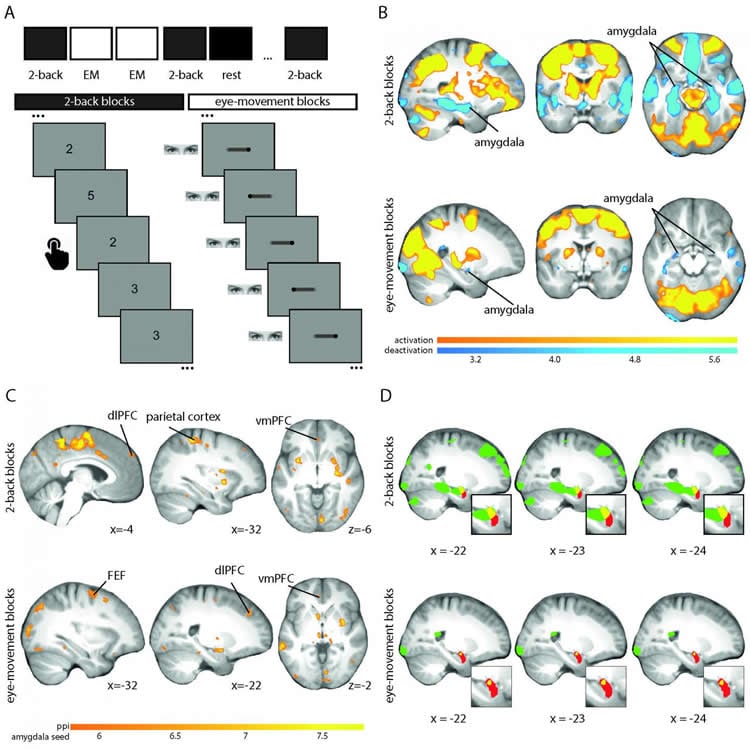Summary: Researchers report EMDR, a widely used but controversial psychotherapy technique, can help suppress fear related amygdala activity during the recall of traumatic memories.
Source: SfN.
Two human experiments published in Journal of Neuroscience demonstrate that a widely used yet controversial psychotherapy technique suppresses fear-related amygdala activity during recall of a traumatic memory.
WDespite being a common and evidence-based therapy, Eye Movement Desensitization and Reprocessing (EMDR) — discovered serendipitously in 1987 by a psychologist while walking in the woods — it is unclear whether the eye movements in this treatment provide any additional benefits to patients struggling with fear-related disorders that are not readily achieved through traditional exposure therapy.
The promise of EMDR is its potential to recode the emotional content of the traumatic memory itself.
Investigating the neurobiological mechanisms underlying EMDR in healthy men and women, Lycia de Voogd and colleagues found that both side-to-side eye movement and a working memory task independently deactivated the amygdala — a brain region critical for fear learning.

The researchers show in a second experiment that this deactivation enhanced extinction learning — a cognitive behavioral technique that reduces the association between a stimulus and a fear response.
The reduced amygdala activity is thought to be a consequence of less available resources since they are dedicated to making eye movements.
Funding: This work was supported by EMDR Research Foundation, European Research Council.
Source: David Barnstone – SfN
Publisher: Organized by NeuroscienceNews.com.
Image Source: NeuroscienceNews.com image is credited to de Voogd et al., JNeurosci (2018).
Original Research: Abstract for “Eye-movement intervention enhances extinction via amygdala deactivation” by Lycia D. de Voogd, Jonathan W. Kanen, David A. Neville, Karin Roelofs, Guillén Fernández and Erno J. Hermans in Journal of Neuroscience. Published September 4 2018.
doi:10.1523/JNEUROSCI.0703-18.2018
[cbtabs][cbtab title=”MLA”]SfN”Eye Movements Take Edge off Traumatic Memories.” NeuroscienceNews. NeuroscienceNews, 4 September 2018.
<https://neurosciencenews.com/traumatic-memory-eye-movements-9797/>.[/cbtab][cbtab title=”APA”]SfN(2018, September 4). Eye Movements Take Edge off Traumatic Memories. NeuroscienceNews. Retrieved September 4 2018 from https://neurosciencenews.com/traumatic-memory-eye-movements-9797/[/cbtab][cbtab title=”Chicago”]SfN”Eye Movements Take Edge off Traumatic Memories.” https://neurosciencenews.com/traumatic-memory-eye-movements-9797/ (accessed September 4 2018).[/cbtab][/cbtabs]
Abstract
Eye-movement intervention enhances extinction via amygdala deactivation
Improving extinction learning is essential to optimize psychotherapy for persistent fear-related disorders. In two independent studies (both n=24), we found that goal-directed eye movements activate a dorsal fronto-parietal network and transiently deactivate the amygdala ([graphic1]=.17). Connectivity analyses revealed that this down-regulation potentially engages a ventromedial prefrontal pathway known to be involved in cognitive regulation of emotion. Critically, when eye movements followed memory reactivation during extinction learning, it reduced spontaneous fear recovery 24 hours later ([graphic2]=.21). Stronger amygdala deactivation furthermore predicted a stronger reduction in subsequent fear recovery after reinstatement (r=.39). In conclusion, we show that extinction learning can be improved with a non-invasive eye-movement intervention that triggers a transient suppression of the amygdala. Our finding that another task which taxes working memory leads to a similar amygdala suppression furthermore indicates that this effect is likely not specific to eye movements, which is in line with a large body of behavioral studies. This study contributes to the understanding of a widely used treatment for traumatic symptoms by providing a parsimonious account for how working memory tasks and goal-directed eye movements can enhance extinction-based psychotherapy, namely through neural circuits (e.g., amygdala deactivation) similar to those that support cognitive control of emotion.
Significant statement
Fear-related disorders represent a significant burden on individual sufferers and society. There is a high need to optimize treatment, in particular via non-invasive means. One potentially effective intervention is execution of eye movements following trauma recall. However, a neurobiological understanding of how eye movements reduce traumatic symptoms is lacking. We demonstrate that goal-directed eye-movements, like working memory tasks, deactivate the amygdala, the core neural substrate of fear learning. Effective connectivity analyses revealed amygdala deactivation potentially engaged dorsolateral and ventromedial prefrontal pathways. When applied during safety learning, this deactivation predicts a reduction in later fear recovery. These findings provide a parsimonious and mechanistic account of how behavioral manipulations taxing working memory and suppressing amygdala activity can alter retention of emotional memories.







